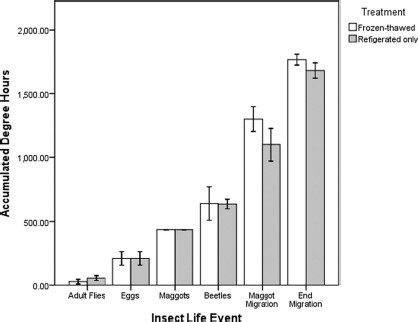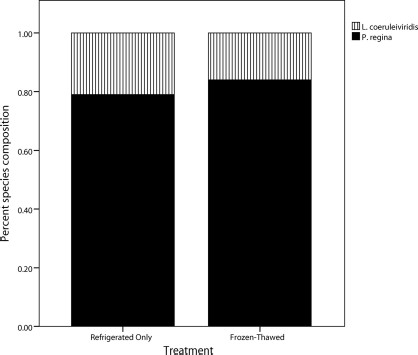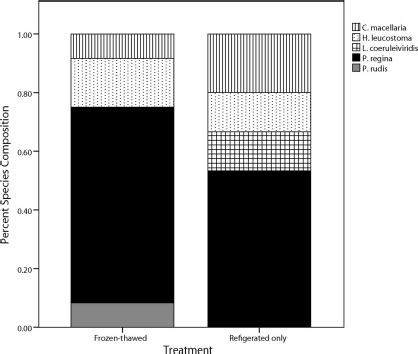-
PDF
- Split View
-
Views
-
Cite
Cite
Kristi N. Bugajski, Cara C. Seddon, Ralph E. Williams, A Comparison of Blow Fly (Diptera: Calliphoridae) and Beetle (Coleoptera) Activity on Refrigerated Only versus Frozen-Thawed Pig Carcasses in Indiana, Journal of Medical Entomology, Volume 48, Issue 6, 1 November 2011, Pages 1231–1235, https://doi.org/10.1603/ME10215
Close - Share Icon Share
Abstract
To have large numbers of replicates in forensic entomology research, it is often necessary to freeze carcasses and thaw them before use in experiments. Research on the effects of freezing on decomposition is minimal in the literature and the effect that it has on insect (e.g., blow fly, beetle) activity is virtually unknown. The objective of this study was to compare the differences in insect activity occurring on refrigerated only versus frozen-thawed pig carcasses, and to characterize the associated dipteran fauna. Seven pigs, frozen for 2 mo and then thawed before the experiment, were compared with seven pigs killed and stored in a walk in refrigerator ≈12 h before the start of the experiment. No significant differences in time to the appearance of adult flies, eggs, larvae, or the initiation and conclusion of larval migration were observed between refrigerated only and frozen-thawed pig carcasses. Beetles from the family Staphylinidae also did not show a significant difference in arrival times. Phormia regina (Meigen), Lucilia coeruleiviridis (Macquart), Cochliomyia macellaria (F.), Pollenia rudis (F.), and Hydrotaea leucostoma (F.) comprised the dipteran taxa present on the carcasses. Results suggest that freezing pigs before exposure in the field does not significantly alter blow fly life events or the appearance of staphylinid beetles.
Forensic entomology is the use of arthropods in legal investigations (Hall and Haskell 1995). Many studies have been conducted to determine effects of different environmental conditions on the biology of forensically important insect species. Because the opportunity to work with human remains is limited, the ability to identify and work with experimental systems that closely approximate the human body is important for the advancement of forensic science. Domestic pigs (Sus scrofa L.) have been used as suitable surrogates for human remains (Schoenly et al. 2006). The ability of researchers to procure a suitable number of pig carcasses for adequate replication can sometimes be problematic. Freezing pigs until enough are collected is one potential solution to the problem, but the potential influence of freezing on the suitability of the carcass and subsequent insect activity after thawing have not been studied.
There have been a few studies examining the various effects of freezing on animal tissues. Gye (1949) found that frozen mouse tumors possess the same tumorigenic qualities as unfrozen tumors after implantation in mice. In general, dermal and epidermal tissues are very tolerant to freezing (Billingham and Medawar 1952). Stokes et al. (2009) studied the effects of freezing on skeletal muscle tissue and its decomposition in soil. They found that freezing skeletal muscle tissue had no impact on the rate of tissue loss when compared with tissue that was only refrigerated. They also found that the chemistry of the soil was not affected differently by tissues that were frozen.
Micozzi (1986) conducted a study comparing fresh pigs to frozen-thawed pigs and their decomposition rates. He found that frozen pigs showed mostly aerobic decomposition while fresh pigs showed anaerobic decomposition. After 2 d, frozen pigs were more visibly decomposed than fresh pigs. After 6 d, there were no visible differences between treatments. Although the rate of disarticulation was slower in fresh pigs than frozen-thawed, the sequence of decomposition was the same. The Micozzi (1986) experiment did not contain statistical analysis or compare insect activity on the pigs. No studies examining how freezing pig carcasses influences subsequent insect activities have been reported.
Day and Wallman (2006) studied the effects that freezing sheep liver had on calliphorid larval growth. They took 20 Calliphora augur (Diptera: Calliphoridae) (F.) larvae and placed them on either fresh or frozen-thawed sheep liver, allowed them to feed and then growth was compared. Only one sampling day out of 11 showed a significant difference in body lengths between treatments. The authors concluded that there was no significant difference in the growth of the maggots between the two substrates.
Because freezing is an important and usually necessary part of forensic entomology research, a study was conducted to determine its effects on carrion insect activity. The objective of this study was to describe differences in dipteran and coleopteran activity between refrigerated only and frozen-thawed pigs.
Materials and Methods
Fourteen pigs weighing an average of 1 kg each were obtained at two different times from the Purdue University Swine Production Facility. The first seven pigs were obtained and frozen in garbage bags for a period of 2 mo before the experiment. The frozen pigs were thawed in a room without fly access for a period of 18 h before use in the experiment. The second set of seven pigs were killed 12 h before the beginning of the experiment and stored in a walk in refrigerator before use. They were allowed to warm to room temperature in a room without fly access for 2 h before field placement. They were stored in the refrigerator to give the frozen pigs adequate thawing time. The experiment took place in June 2010 at Purdue University in West Lafayette, IN.
Pigs were placed into nonshaded, randomized 1.5 m × 1.5 m plots within a 15.2 m × 15.2 m research compound with 1.5 m high galvanized steel walls with a sunken concrete base and an electric fence around the top. Reflective streamers were attached to trees to dissuade birds from entering the compound. A random number generator was used to assign each pig to a plot using a stratified random block design. In the plots, pigs were ≈1 m apart.
Pigs were observed twice daily (0900, 1500 hours), until larvae reached the third-instar larval post feeding stage. During sampling, photos were first taken of each of the 14 pigs. Notes documenting the following insect life events were then recorded: presence of adult flies, presence of fly eggs, presence of fly larvae, presence of beetles, larval migration, and the end of larval migration. Notes were taken by walking into each plot and examining the carcasses, with the exception of adult flies. Adult flies were monitored from a distance of ≈1.5 m so the adults were not startled. After the notes were taken, adult flies and larvae were collected. Adults were collected using aerial nets and were preserved in 70% ethanol. Using forceps, one vial of larvae was collected per pig per collection. Larvae were killed and preserved in KAA (77% ethanol, 15% acetic acid, and 8% kerosene). Identifications were made using Smith (1986) and Whitworth (2006).
Analysis.
Two-tailed t-tests were used to compare differences in the mean initial occurrence (arrival times) of six insect life events between the frozen-thawed and refrigerated only pigs. Data were analyzed using PASW Statistics 18, statistical software by SPSS, Inc. (SPSS 2009). An analysis of similarities was used to determine if dissimilarities were present in the species composition of blow flies in the treatments. A normalized, nonstandardized, Euclidian distance with a square-root transformation on abundance within species was used to create a similarity matrix. Using this matrix, the analysis of similarities was done using Primer software (Clarke and Gorley 2001). Statistical significance was tested with a randomization procedure iterated 999 times.
Results
No significant difference in the time to first appearance of adult flies (t = 1.04, df = 12, P = 0.32), eggs (df = 12, P = 1.0), larvae (df = 12, P = 1.0), or Staphylinidae (Coleoptera) beetles (t = −0.28, df = 12, P = 0.98) were observed between frozen-thawed and refrigerated only pig carcasses during the course of the experiment, and the time to initiation of larval migration (t = −1.25, df = 12, P = 0.23) and the end of larval migration (t = −1.2, df = 12, P = 0.27) did not vary significantly between the two treatments (Fig. 1).

Accumulated degree hours for six different insect life events: adults, eggs, larvae, beetles, larval migration and end larval migration. The error bars represent ± 1 SE.
Phormia regina (Diptera: Calliphoridae) (Meigen) was the most abundant species of adults and larvae collected in both treatments (Figs. 2 and 3). In both treatments, P. regina comprised ≈80% of collected larvae, while Lucilia coeruleiviridis (Diptera: Calliphoridae) (Macquart) comprised the remainder of larvae collected (Fig. 2). P. regina, Cochliomyia macellaria (Diptera: Calliphoridae) (F.) and Hydroatea leucostoma (Diptera: Calliphoridae) (F.) were collected as adults from refrigerated only and frozen-thawed treatments (Fig. 3). The only difference in species composition between treatments was that Pollenia rudis (Diptera: Calliphoridae) (F.) adults were only collected from frozen-thawed pigs and L. coeruleiviridis adults were only collected from refrigerated only pigs (Fig. 3). Staphylinidae beetles were the only Coleoptera found and were collected from refrigerated only and frozen-thawed pigs. The analysis of similarities found no significant dissimilarities in the species totals of adults (R = −0.052, P = 0.75) or larvae (R = −0.024, P = 0.48) collected.

Mean percent species composition of larvae collected from refrigerated only and frozen-thawed pig carcasses in June 2010.

Mean percent species composition of adult flies collected from refrigerated only and frozen-thawed pig carcasses in June 2010.
Discussion
The postmortem interval, or PMI, is the time that has passed since death (Hall and Huntington 2008). Forensic entomological assessments can be useful in estimations of the PMI when insects are present (Catts and Goff 1992, Hall and Huntington 2008, Wells and Lamotte 2010). Research projects studying blow flies and factors that affect the entomologist's estimation of the PMI will sometimes use frozen carrion (Greenberg 1990, Vance et al. 1995, Shea 2005, Baldridge et al. 2006, Voss et al. 2009). It has been noted in previous papers that differences exist in the decomposition process between fresh and frozen carrion. Most notably, the exterior of frozen carrion decomposed faster than the exterior of fresh carrion (Micozzi 1986, Zugibe and Costello 1993). This current study did not observe any significant differences in blow fly life events, or in the arrival of beetles from the family Staphylinidae.
Pigs weighing 1 kg were used because of their availability and using these pigs allowed for more replication. Schoenly et al. (2007) found that 25 kg pigs were suitable substitutes for humans in research. This study did not aim to make comparisons between pig decomposition and human decomposition, so the size of the pigs used in this experiment is adequate. Because similar sized pigs were used in both treatments, size did not affect the goal of determining differences between refrigerated only and frozen-thawed and pigs. Larger pigs would yield longer experiments and future research could examine freezing effects on different sized carrion.
The Day and Wallman (2006) study provided valuable data on the growth of maggots on fresh versus frozen-thawed substrates. However, they only focused on the growth of maggots and no other important life stages. The current study used pig carcasses and examined five blow fly life stages, including oviposition timing that is critical in PMI estimations.
Upon external examination, no visible differences were noted between refrigerated only and frozen-thawed pigs. As decomposition progressed, the frozen-thawed pigs had more discoloration than the refrigerated only pigs. This was the only noticeable visual difference between the treatments.
The flies collected from pigs were consistent with previous studies. Haskell (1989) found that in the summer in Rensselaer, IN, P. regina comprised 85% of the total specimens, with the Lucilia species represented at 10% and C. macellaria 5%. The current study found that P. regina comprised 80% of collected larvae, and L. coeruliviridis the other 20%. Freezing did not significantly impact the sequence of blow fly activity on the carcasses, nor did it affect the species composition. The high P values from the analysis of similarities suggest that flies did not prefer one treatment over another. Even though there were a few differences in the species collected, they were not significant. In this study, freezing and thawing a carcass before field placement yielded a similar species composition to carcasses that were only refrigerated.
It is important to note that in this research sampling occurred twice daily and this should be taken into consideration when examining the amount of accumulated degree hours between life events. If sampling occurred at 1500 hours and eggs were laid at 1505 hours, they would not be recorded until the next sampling period. This could result in as much of a 16 h difference in actual first appearance and recorded first appearance. It is important to include this difference in the reported range of the PMI.
Results of the current study suggest that freezing carrion before placement in the field is a reliable method for obtaining large numbers of replicates, which is a crucial part of forensic research. The utility of forensic entomology is focused on human death investigation, and in human decomposition research the bodies are typically frozen before use for replication purposes. Because a major facility that uses humans in their research freezes bodies before experiments, it is imperative for entomologists to know the effect that freezing has on insect activity.
Acknowledgments
We thank Patrick Jones for his assistance with the project and Dick Byrd and associates with the Purdue University Swine Production Facility for supplying the pigs. We would also like to thank Neal Haskell and Jeff Holland for their help preparing the manuscript.
References Cited



